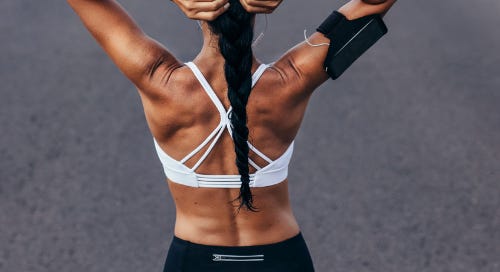Keep Your Cool
In this week's Rundown, a wearable monitors core body temperature, mice lead the way on what time of day we should exercise and muscle is key to protecting middle aged hearts, at least for men.
Keep Your Cool. The CORE body temperature sensor (find it here) is a new wearable that gives you access to live temperature data so you can monitor your individual heat response and manage your cooling needs while training. Stuck directly to your skin or attached to a heart rate chest strap, it continuously measures and broadcasts your core body temperature to several effort tracking apps on iOS, Android, Garmin Connect IQ and Wahoo devices. The monitor works with technology from CORE’s parent company, greenTEG. Inside is a tiny energy transfer sensor that measures the amount of energy being transferred from your body into the environment. This measurement of heat loss is extrapolated to calculate your core body temperature with claimed accuracy of +/-0.21 degrees Celsius.
CORE is based on the idea that at a certain point when your body cannot shed excess heat during intense efforts, your power output will decrease. Heat effects everyone differently but tracking your body temperature in real time and correlating that temperature to other training metrics like heart rate and power output can help you learn how to better deal with heat, optimize your training methods and choose the best times to use cooling techniques.
Of Mice and Metabolism. A new study featuring mice sheds some light on what time of day we should be exercising. The research, published in Cell Metabolism, (read it here) used three groups of male mice. One group jogged moderately on wheels for an hour early in the day. A second group did the same in the evening. A third group served as a control, remaining inactive on locked wheels during both day and evening. One hour after the mice finished exercising, the research team, led by Juleen Zierath, a professor of clinical integrative physiology at the Karolinska Institute in Stockholm, Sweden, examined almost every molecular change related to metabolism.
What the team found was that exercise timing affected the levels and activities of many molecules throughout the animals’ bodies and earlier workouts relied more on fat than blood sugar as fuel. The caveat, of course, is that people are not mice so it’s not clear if the same molecular impacts would take place. But the research does suggest, at least in mice, that morning exercise may help more with fat loss, while evening workouts may have more impact on controlling blood sugar. Additional studies on human subjects are planned with the idea that we may learn how to time our workouts to reach specific health outcomes.
Muscling Past Heart Disease. Entering middle age with more muscle may reduce your chances of developing heart disease later on, but the impact is different for men and women. Research published in the Journal of Epidemiology and Community Health (read it here) used data from a large-scale study in Greece where several thousand adults who did not have cardiovascular disease, filled out a lifestyle questionnaire and underwent medical exams. The participants returned ten years later for more testing focused on their heart health. The authors of the current study took 1,019 people from this returning group who were now mostly past the age of 55, and calculated each person’s muscle mass using the information from their original medical tests. Then they looked at who had developed heart disease.
What they found was that almost 27 percent of the participants had heart disease (with the results in men six times higher than in women) and those with the most muscle at the study’s beginning were the least likely to have heart disease ten years later. The link was significant even when the researchers controlled for diet, education, and physical activity but not for gender. They concluded that men who had muscle early in middle age reduced their later risk of heart disease by 81 percent but women’s muscle mass was not associated with later risks for heart disease, mainly because so few of them had it.
It’s important to note that the research is not evidence that having lots of muscle directly prevents heart disease, just that the two are related. The study’s lead author, Dr. Stefanos Tyrovolas, suggests a simple takeaway. For men in particular, one key to protecting aging hearts is preserving muscle mass through exercise and an active lifestyle.



